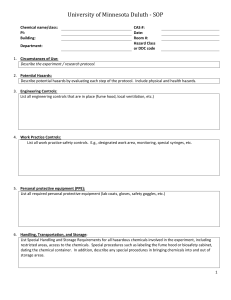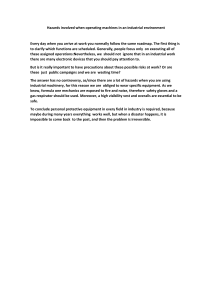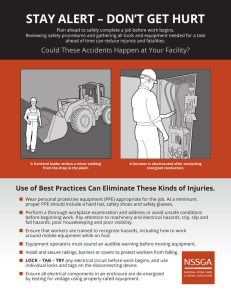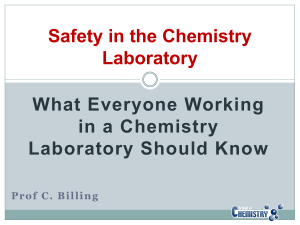Lab Safety Notes: PPE, Equipment, Chemical Hazards & Handling
advertisement
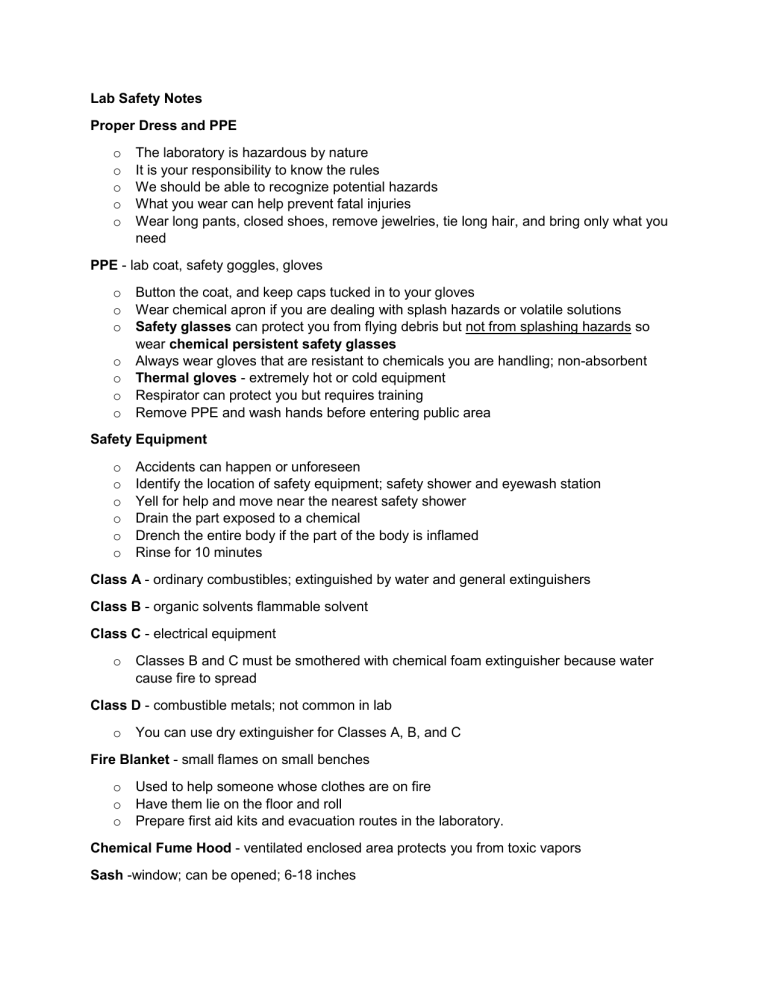
Lab Safety Notes Proper Dress and PPE o o o o o The laboratory is hazardous by nature It is your responsibility to know the rules We should be able to recognize potential hazards What you wear can help prevent fatal injuries Wear long pants, closed shoes, remove jewelries, tie long hair, and bring only what you need PPE - lab coat, safety goggles, gloves o o o o o o o Button the coat, and keep caps tucked in to your gloves Wear chemical apron if you are dealing with splash hazards or volatile solutions Safety glasses can protect you from flying debris but not from splashing hazards so wear chemical persistent safety glasses Always wear gloves that are resistant to chemicals you are handling; non-absorbent Thermal gloves - extremely hot or cold equipment Respirator can protect you but requires training Remove PPE and wash hands before entering public area Safety Equipment o o o o o o Accidents can happen or unforeseen Identify the location of safety equipment; safety shower and eyewash station Yell for help and move near the nearest safety shower Drain the part exposed to a chemical Drench the entire body if the part of the body is inflamed Rinse for 10 minutes Class A - ordinary combustibles; extinguished by water and general extinguishers Class B - organic solvents flammable solvent Class C - electrical equipment o Classes B and C must be smothered with chemical foam extinguisher because water cause fire to spread Class D - combustible metals; not common in lab o You can use dry extinguisher for Classes A, B, and C Fire Blanket - small flames on small benches o o o Used to help someone whose clothes are on fire Have them lie on the floor and roll Prepare first aid kits and evacuation routes in the laboratory. Chemical Fume Hood - ventilated enclosed area protects you from toxic vapors Sash -window; can be opened; 6-18 inches Behavior o o o o o o o o o o o o Follow written standard operation procedures Never eat, drink, apply make up to the lab These can contaminate experiment Always have one other person in the lab Don’t place chemical bottles in areas where they can fall If they spill on the floor, check data sheet for appropriate response For routine spill, clean immediately Always keep your workbench clean Don’t place materials near edge Don’t pick broken glass with bare hands Dispose chemicals properly Clean workbench with ethanol or isopropyl alcohol Chemical Hazards o high heat, pressure, exposed to other chemicals Safety Data Sheets o o o provided by manufacturer Material Safety Data Sheet (MSDS) Find out about chemical properties, hazards, and safety precautions GHS or Globally Harmonized System of classification and labelling of chemicals. Identification - chemical's name, description, anufacturers contact info Hazard Identification - warnings, signals, safety symbols Composition - ingredients First Aid - required treatment Accidental Release - for containment and clean up Handling and Storage Exposure Controls and Personal Protection - recommendation for PPE Physical and Chemical Properties - appearance, odor, pH, solubility Stability and Reactivity - how to avoid hazardous reactions Toxicological - exposure symptoms, short and long-term effects Ecological Disposal Transport Regulatory Chemical Labels o o o o o o labeled with product name signal word physical and environmental hazard precautionary statement pictogram suppliers contact info o health, flammability, toxicity, compressed gases, skin and eye protection, unstable explosives, oxidizer (initiate combustion) environmental hazards, acute toxicity o Safe Chemical Handling o o o o o prepare for each lab activity when diluting acid base, add acid or base to salt pour solute or acid to the solvent; not the other way around because it can cause violent reaction use break resistant container handle chemicals safely In protecting your eyes… o o o o splash googles - marked with code z87-1 compliance with American standards prescription glasses don’t provide protection use full face shield or goggles When working on corrosive chemicals… o o chemical resistant lab apron- best choice when working with splash hazards full arm length rubber gloves - highly corrosive NOTE: o o o o o o o o o never smell chemicals work with toxic chemical under fume hood large spills should be cleaned by qualified personnel flammable require special handling techniques; keep from brush and burners store in grounded dedicated storage properly dispose do not evaporate under fume hood paper towels are also hazardous; disposed accordingly know what you’re working with and how to handle it

